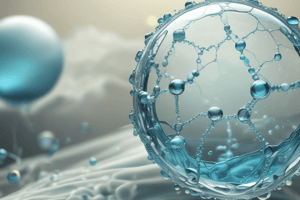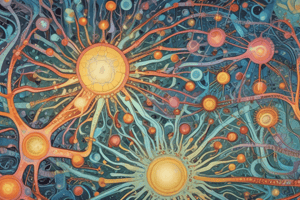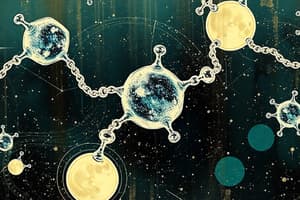Podcast
Questions and Answers
Which of the following molecules contains both an amino group and an acidic group, and is a building block for proteins like hemoglobin, insulin, and trypsin?
Which of the following molecules contains both an amino group and an acidic group, and is a building block for proteins like hemoglobin, insulin, and trypsin?
- Phospholipid
- Triglyceride
- Carbohydrate
- Amino acid (correct)
A molecule that has undergone at least one dehydration reaction can be classified as a monomer.
A molecule that has undergone at least one dehydration reaction can be classified as a monomer.
False (B)
What type of molecule forms the lipid bilayer of a cell's plasma membrane?
What type of molecule forms the lipid bilayer of a cell's plasma membrane?
phospholipid
The molecule that is the major storage form of energy in animal cells is known as ____________.
The molecule that is the major storage form of energy in animal cells is known as ____________.
Which molecule is a precursor to steroid hormones like testosterone and progesterone?
Which molecule is a precursor to steroid hormones like testosterone and progesterone?
Match the following types of molecules with their primary function or characteristic:
Match the following types of molecules with their primary function or characteristic:
Carbon is known for its ability to form a variety of complex molecules. What property of carbon is MOST responsible for this?
Carbon is known for its ability to form a variety of complex molecules. What property of carbon is MOST responsible for this?
How many covalent bonds does a nitrogen atom typically form in organic molecules, and why?
How many covalent bonds does a nitrogen atom typically form in organic molecules, and why?
An uncharged carbon atom has six protons and six neutrons. How many electrons does it have?
An uncharged carbon atom has six protons and six neutrons. How many electrons does it have?
Isomers are molecules that have the same molecular formula but different structural formulas and properties.
Isomers are molecules that have the same molecular formula but different structural formulas and properties.
What type of bond is formed when two atoms share electrons to fill their valence shells?
What type of bond is formed when two atoms share electrons to fill their valence shells?
A substance that minimizes changes in pH when acids or bases are added to a solution is called a ______.
A substance that minimizes changes in pH when acids or bases are added to a solution is called a ______.
Match the following functional groups with their corresponding chemical formula:
Match the following functional groups with their corresponding chemical formula:
How many covalent bonds can a carbon atom typically form?
How many covalent bonds can a carbon atom typically form?
Which of the following forces contributes LEAST to the stability of a protein's tertiary structure?
Which of the following forces contributes LEAST to the stability of a protein's tertiary structure?
Which of the following best describes the relationship between the sequence of amino acids in a protein and the function of that protein?
Which of the following best describes the relationship between the sequence of amino acids in a protein and the function of that protein?
ATP contains an element not found in triglycerides. Which element is it?
ATP contains an element not found in triglycerides. Which element is it?
A diagram depicts a molecule with a base connected to a pentose sugar, and one to three phosphate groups attached. What does this molecule represent?
A diagram depicts a molecule with a base connected to a pentose sugar, and one to three phosphate groups attached. What does this molecule represent?
Which of the following is NOT an example of, or does not contain, a steroid?
Which of the following is NOT an example of, or does not contain, a steroid?
Which biological molecule contains nitrogen but not starch?
Which biological molecule contains nitrogen but not starch?
Which of the following molecules does not exhibit hydrogen bonding?
Which of the following molecules does not exhibit hydrogen bonding?
Which components are found in a nucleotide?
Which components are found in a nucleotide?
What structural component differs between RNA and DNA?
What structural component differs between RNA and DNA?
Which nitrogenous base is typically found in RNA but not in DNA?
Which nitrogenous base is typically found in RNA but not in DNA?
Flashcards
Proton's charge
Proton's charge
Positive charge
Electron's charge
Electron's charge
Negative charge
Neutron's charge
Neutron's charge
No charge (neutral)
Atom vs. Ion (Potassium)
Atom vs. Ion (Potassium)
Signup and view all the flashcards
Buffer
Buffer
Signup and view all the flashcards
pH increase from 9 to 12
pH increase from 9 to 12
Signup and view all the flashcards
Bond within water molecule
Bond within water molecule
Signup and view all the flashcards
Bond between water molecules
Bond between water molecules
Signup and view all the flashcards
Neutral Atom
Neutral Atom
Signup and view all the flashcards
Water molecule attraction
Water molecule attraction
Signup and view all the flashcards
Effect of HCl on pH
Effect of HCl on pH
Signup and view all the flashcards
Bond X (Water)
Bond X (Water)
Signup and view all the flashcards
Carbo-loading
Carbo-loading
Signup and view all the flashcards
Sucrose Formula
Sucrose Formula
Signup and view all the flashcards
Phospholipid parts
Phospholipid parts
Signup and view all the flashcards
Amino acid definition
Amino acid definition
Signup and view all the flashcards
Nucleotide
Nucleotide
Signup and view all the flashcards
Triglyceride elements
Triglyceride elements
Signup and view all the flashcards
Nitrogen in biomolecules
Nitrogen in biomolecules
Signup and view all the flashcards
Hydrogen bonding
Hydrogen bonding
Signup and view all the flashcards
RNA vs DNA
RNA vs DNA
Signup and view all the flashcards
Uracil vs. Thymine
Uracil vs. Thymine
Signup and view all the flashcards
Hydrogen bonds hold?
Hydrogen bonds hold?
Signup and view all the flashcards
Glucose test-kits
Glucose test-kits
Signup and view all the flashcards
Study Notes
- Electric charges of subatomic particles: protons are positive, electrons are negative, neutrons have no charge.
- Potassium atoms and potassium ions both have the same number of protons, but a different number of electrons.
- A buffer resists large changes in pH.
- pH rises from 9 to 12:
- The solution becomes 1000 times more basic.
- Bonding within a water molecule is covalent, while bonding between two water molecules is hydrogen.
- Hydrophilic molecules are polar and water-loving, while hydrophobic molecules are nonpolar and water-fearing.
- Polymer and corresponding monomer: protein and amino acid.
- Reactions producing water molecule: formation of a peptide bond between alanine and lysine.
- Example of dehydration reaction: conversion of monosaccharides into polysaccharides.
- Glucose, ribose, and sucrose are classified as carbohydrates.
- Glucose, ribose, and sucrose have twice as many hydrogen atoms as oxygen atoms.
- Bonding glucose and ribose results in a disaccharide.
- Hydrolysis of a triglyceride gives you three fatty acids and a glycerol molecule, requiring three water molecules.
- Unsaturated fats contain more hydrogen atoms compared to saturated fats.
- Distinction between phospholipid and triglyceride: A phospholipid has a phosphate group, while a triglyceride has a fatty acid.
- Cholesterol can be converted into the female sex hormone estrogen.
- Polymer produced from a molecule: stores genetic information.
- A substance produced from the molecule is keratin.
- In a dehydration reaction with radioactive nitrogen-15, the nitrogen would likely be incorporated into insulin.
- Bond X in the diagram is a peptide bond.
- The R group makes each subunit unique from the other subunits.
- The "H" attached to the central carbon represents the R group.
- Hydrolysis of the molecule will produce amino acids.
- There are 4 monomers present in the molecule.
- Hydrogen bonding is responsible for the alpha helix structure between the subunits of the molecule.
- Primary structure of a protein is determined by the linear sequence of amino acids.
- Proteins have different functions due to polypeptide chains that fold differently because of hydrogen bonding and have different amino acid sequences.
- When ATP breaks down to ADP, energy is released.
- The element present in ATP, but not in a triglyceride, is phosphorus.
- The molecule represents a nucleotide.
- Structure B is a nitrogenous base.
- Glycogen is another biological molecule that has structure B.
- Nitrogen is present in RNA and a protein but not in starch.
- Triglycerides do not have hydrogen bonding.
- The components of a nucleotide may include a phosphate group, a nitrogenous base, and a ribose sugar.
- The component that is different between RNA and DNA is the pentose sugar.
- The base usually used to synthesize RNA, but not DNA, is uracil.
- Components of DNA held together by hydrogen bonds: cytosine and guanine.
- Glucose in juice can be tested using safety goggles, juice, Benedict's solution, test tube, test tube tongs, graduated cylinder, hot plate, beaker, water, rubber gloves.
- Molecules matched to their descriptions:
- Building block of phospholipid (5, 7).
- Monomer of collagen / keratin (4).
- Carbohydrates (1, 2, 3, 6, 8).
- Precursor to testosterone/progesterone (11).
- Long-term energy storage in plants (14).
- In phospholipids and triglycerides (7).
- Structural support in plant cell wall (1).
- Primary energy source (2).
- Molecule with amino and acidic group (4).
- Major storage form of energy in animals (3).
- Already undergone dehydration reaction (9, 10, 12, 13, 14).
- Building block for hemoglobin, insulin, trypsin (4).
- Inorganic for most chemical reactions in the body (5).
Studying That Suits You
Use AI to generate personalized quizzes and flashcards to suit your learning preferences.




